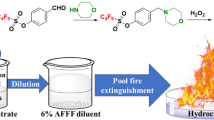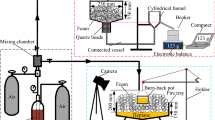Abstract
Aqueous film-forming foam (AFFF) is widely used in both military and civilian applications as an effective method to suppress flammable liquid fires. The present study focuses on identifying the contribution of different foam stabilizers to performance of AFFF. Carboxymethylcellulose, xanthan gum, triethanolamine and lauryl alcohol, are chosen as foam stabilizers of AFFF to synthetize AFFF formulation concentrates, and their mass concentration in AFFF is varied in the range of 0–2%, 0–0.4%, 0–4%, and 0–3%, respectively. Subsequently, the properties of AFFF aqueous solutions, including surface tension, interfacial tension, film-forming property, viscosity and foaming ability are measured. In particular, a new apparatus is established to evaluate the effect of foam stabilizers on foam drainage and foam spreading property. Finally, fire extinguishing tests and burn-back tests of AFFF containing different foam stabilizers are performed with a circular pan, 0.25 m2 in surface area. The results indicated that film-forming property and foam spreading property are decreased by the addition of the foam stabilizers. Foam stability of AFFF can be enhanced by the addition of carboxymethylcellulose and xanthan gum but reduced by the addition of triethanolamine and lauryl alcohol. The AFFF containing 0.4% xanthan gum shows the optimal foam stability, but the AFFF containing 0.3% xanthan gum shows the optimal fire extinguishing performance. This indicates that fire extinguishing efficiency is affected by multiple factors. In selecting foam stabilizers we need to be trading off factors such as film-forming property, foam stability and foam spreading property.







Similar content being viewed by others
References
Figueredo RCR, Sabadini E (2003) Firefighting foam stability: the effect of the drag reducer poly (ethylene) oxide. Colloids Surf A: Physicochem Eng Asp 215:77–86.
Kennedy MJ, Conroy MW, Dougherty JA, Otto N, Williams BA, Ananth R, Fleming JW (2015). Bubble coarsening dynamics in fluorinated and non-fluorinated firefighting foams. Colloids Surf A: Physicochem Eng Asp 470:268–279
Manzello SL, Yang JC (2002) The effect of an alcohol resistant aqueous film forming foam (AR-AFFF) on the evaporation, boiling, and collision dynamics of a water droplet on a heated solid surface. J Colloid Interface Sci 256:418–427
Schaefer TH, Dlugogorski BZ, Kennedy EM (2008) Sealability properties of fluorine-free fire-fighting foams (FfreeF). Fire Technol 44:297–309
Magrabi SA, Dlugogorski BZ, Jameson GJ (2002) A comparative study of drainage characteristics in AFFF and FFFP compressed-air fire-fighting foams. Fire Saf J 37:21–52
Persson B, Dahlberg M (1994) A simple model for predicting foam spread over liquids. Fire Saf Sci 4:265–276
Lattimer BY, Trelles J (2007) Foam spread over a liquid pool. Fire Saf J 42:249–264
Stubley D, Mulligan DJ (1988) The effect of aqueous surfactant films on the ignitability of aviation kerosene. Fire Technol 24:110–115
D’Agostino LA, Mabury SA (2013) Identification of novel fluorinated surfactants in aqueous film forming foams and commercial surfactant concentrates. Environ Sci Technol 48:121–129
Williams B, Murray T, Butterworth C, Burger Z, Sheinson R, Fleming J, Farley J (2011) Extinguishment and burn-back tests of fluorinated and fluorine-free firefighting foams with and without film formation. In Suppression, detection, and signaling research and applications—a technical working conference (SUPDET 2011).
Wang L, Yoon RH (2004) Hydrophobic forces in the foam films stabilized by sodium dodecyl sulfate: effect of electrolyte. Langmuir 20:11457–11464
Bergeron V, Waltermo Å, Claesson PM (1996) Disjoining pressure measurements for foam films stabilized by a nonionic sugar-based surfactant. Langmuir 12:1336–1342
Petkova R, Tcholakova S, Denkov ND (2012) Foaming and foam stability for mixed polymer–surfactant solutions: effects of surfactant type and polymer charge. Langmuir 28:4996–5009
Carn F, Colin A, Pitois O, Vignes-Adler M, Backov R (2009) Foam drainage in the presence of nanoparticle- surfactant mixtures. Langmuir 25:7847–7856
Kristen N, Vüllings A, Laschewsky A, Miller R, von Klitzing R (2010) Foam films from oppositely charged polyelectolyte/surfactant mixtures: effect of polyelectrolyte and surfactant hydrophobicity on film stability. Langmuir 26:9321–9327
Maldonado-Valderrama J, Martín-Molina A, Martín-Rodriguez A, Cabrerizo-Vílchez MA, Gálvez-Ruiz MJ, Langevin D (2007) Surface properties and foam stability of protein/surfactant mixtures: theory and experiment. J Phys Chem C 111:2715–2723
Regismond ST, Winnik FM, Goddard ED (1998) Stabilization of aqueous foams by polymer/surfactant systems: effect of surfactant chain length. Colloids Surf A: Physicochem Eng Asp 141:165–171
Goodwin J (2004) Colloids and interfaces with surfactants and polymers: an introduction. Wiley: UK
Duan M, Hu X, Ren D, Guo H (2004) Studies on foam stability by the actions of hydrophobically modified polyacrylamides. Colloid Polym Sci 282: 1292–1296
Zhang H, Miller CA, Garrett PR, Raney KH (2005) Lauryl alcohol and amine oxide as foam stabilizers in the presence of hardness and oily soil. J Surfactants Deterg 8:99–107
Dickinson E (2010) Food emulsions and foams: stabilization by particles. Curr Opin Colloid Interface Sci 15:40–49
Gonzenbach UT, Studart AR, Tervoort E, Gauckler LJ (2006) Stabilization of foams with inorganic colloidal particles. Langmuir 22:10983–10988
Alargova RG, Warhadpande DS, Paunov VN, Velev OD (2004) Foam superstabilization by polymer microrods. Langmuir 20:10371–10374
Stocco A, Drenckhan W, Rio E, Langevin D, Binks BP (2009) Particle-stabilised foams: an interfacial study. Soft Matter 5:2215–2222
Zhu Y, Pei X, Jiang J, Cui Z, Binks BP (2015) Responsive aqueous foams stabilized by silica nanoparticles hydrophobized in situ with a conventional surfactant. Langmuir 31:12937–12943
Cui ZG, Cui YZ, Cui CF, Chen Z, Binks BP (2010) Aqueous foams stabilized by in situ surface activation of CaCO3 nanoparticles via adsorption of anionic surfactant. Langmuir 26:12567–12574
Woodman AL, Richter HP, Adicoff A, Gordon AS (1978) AFFF spreading properties at elevated temperatures. Fire Technol 14:265–272
Sheinson RS, Williams BA, Green C, Fleming JW, Anleitner R, Ayersa S, Barylski D (2002) The future of aqueous film forming foam (AFFF): performance parameters and requirements. National Institute of Standards and Technology (US Dept of Commerce).
GB15308-2006: Foam extinguishing agent
BS EN 1568-3-2008: Fire extinguishing media-Foam concentrates-Part 3: specification for low expansion foam concentrates for surface application to water-immiscible liquids
DEF(AUST)5706 (2003) Foam, liquid fire extinguishing; 3 percent and 6 percent concentrate specification, Commonwealth of Australia, Australian Defence Standard
Wang D, Hou Q, Luo Y, Zhu Y, Fan H (2015) Stability comparison between particles-stabilized foams and polymer-stabilized foams. J Dispers Sci Technol 36:268–273
Azira H, Tazerouti A, Canselier JP (2008) Study of foaming properties and effect of the isomeric distribution of some anionic surfactants. J Surfactants Deterg 11:279–286
Carey E, Stubenrauch C (2010) Foaming properties of mixtures of a non-ionic (C 12 DMPO) and an ionic surfactant (C 12 TAB). J Colloid Interface Sci 346:414–423
Wilson AJ (1989) Foams: physics, chemistry and structure. Springer Series in Applied Biology
NFPA11 (2010) Standard for low-, medium-, and high-expansion foam
Persson B, Lönnermark A, Persson H (2003) FOAMSPEX: large scale foam application—modelling of foam spread and extinguishment. Fire Technol 39(4):347–362
Dlugogorski BZ, Kennedy EM, Schaefer TH, Vitali J (2002) What properties matter in fire-fighting foams? In: Proceeding of 2nd NRIFD symposium, Tokyo, pp 57–78
Defence Standard 42-40 (2002) Foam liquids, fire extinguishing (concentrates, foam, fire extinguishing), issue 2, UK Ministry of Defence
Laundess AJ, Rayson MS, Dlugogorski BZ, Kennedy EM (2011) Small-scale test protocol for firefighting foams DEF (AUST) 5706: effect of bubble size distribution and expansion ratio. Fire Technol 47:149–162
Laundess AJ, Rayson MS, Dlugogorski BZ, Kennedy EM (2012) Suppression performance comparison for aspirated, compressed-air and in situ chemically generated class B foams. Fire Technol 48:625–640
Villares A, Giner B, Artigas H, Lafuente C, Royo FM (2005) Study of the surface tensions of cyclohexane or methylcyclohexane with some cyclic ethers. J Solut Chem 34:185–198
Korosi G, Kovats ES (1981) Density and surface tension of 83 organic liquids. J Chem Eng Data 26:323-332
Williams BA, Sheinson RS, Taylor JC (2010) Regimes of fire spread across an AFFF–covered liquid pool. NRL Report
Acknowledgements
The present work was supported by the Fundamental Research Funds for the Central Universities (No. WK2320000034), National Key R&D Program of China (No. 2016YFC0802101), and the Opening Fund of State Key Laboratory of Fire Science (SKLFS) under Grant No. HZ2016-KF09, the Opening Fund of State Key Laboratory of Fire Science (No. HZ2017-KF06).
Author information
Authors and Affiliations
Corresponding author
Rights and permissions
About this article
Cite this article
Sheng, Y., Jiang, N., Sun, X. et al. Experimental Study on Effect of Foam Stabilizers on Aqueous Film-Forming Foam. Fire Technol 54, 211–228 (2018). https://doi.org/10.1007/s10694-017-0681-z
Received:
Accepted:
Published:
Issue Date:
DOI: https://doi.org/10.1007/s10694-017-0681-z




